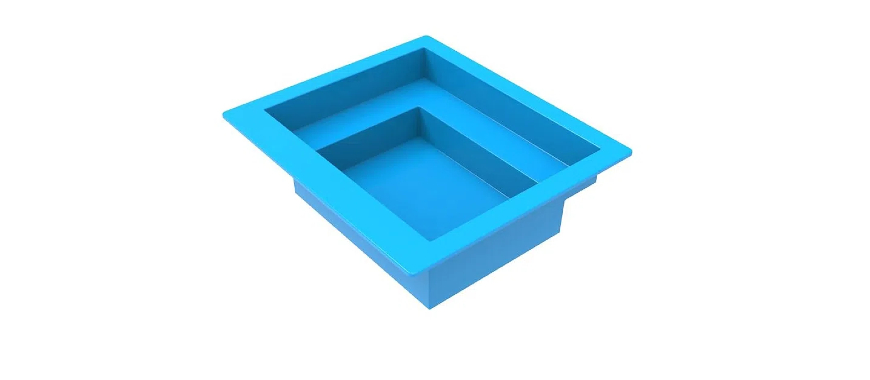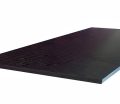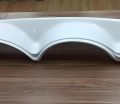
An old aluminum boat with fiberglass bow cap is a classic combination often found in many vintage or well-used boats. The bow cap, typically made of fiberglass, serves an essential purpose in protecting the front of the boat from wear and damage. Over time, these boats experience exposure to harsh marine environments, and maintaining the bow cap is crucial for preserving the boat’s structural integrity and appearance. The fiberglass bow cap offers durability and resistance to corrosion, ensuring that the boat remains protected against the elements. For those who own an old aluminum boat with fiberglass bow cap, regular maintenance and timely repairs are key to ensuring the boat stays functional and aesthetically pleasing for years to come.
The Unique Features of an Old Aluminum Boat with Fiberglass Bow Cap
An old aluminum boat with fiberglass bow cap represents a marriage of function and durability. This design is ideal for those who appreciate the resilience of aluminum combined with the protective and sleek qualities of fiberglass. Boats constructed this way are built to withstand diverse water conditions, making them a preferred choice for seasoned boaters and newcomers alike.
The aluminum hull offers lightweight maneuverability, making navigation in shallow or deep waters an effortless task. Paired with a fiberglass bow cap, the boat benefits from additional impact resistance, reducing damage during docking or accidental bumps against rocks and piers. This fusion of materials not only enhances performance but also adds a refined aesthetic touch that stands out.
Fiberglass bow caps are known for their ability to resist the corrosive effects of saltwater, a significant advantage for those frequently exploring coastal areas. By protecting the boat’s front section, the fiberglass ensures that the underlying aluminum remains intact. Furthermore, the bow cap’s streamlined design improves the hydrodynamic efficiency of the vessel, allowing for smoother sailing.
An additional advantage of an aluminum and fiberglass combination is the ease of customization. Fiberglass’s moldable nature allows for unique modifications to match the owner’s specific needs or preferences. Whether for fishing, leisure cruising, or water sports, this construction accommodates various activities seamlessly.
Advantages of Using a Fiberglass Bow Cap on an Aluminum Boat
- Enhanced Durability: Fiberglass bow caps provide extra strength to withstand impacts and abrasions, safeguarding the aluminum hull.
- Lightweight Protection: Despite its durability, fiberglass adds minimal weight to the boat, preserving the overall agility of the aluminum structure.
- Corrosion Resistance: Fiberglass shields the aluminum bow from exposure to corrosive elements, ensuring longevity.
- Easy Maintenance: Minor damage to the fiberglass can be repaired quickly and economically, unlike integrated metal designs.
- Improved Hydrodynamics: The streamlined profile of the bow cap minimizes water resistance, enhancing the boat’s speed and fuel efficiency.
How to Properly Replace a Fiberglass Bow Cap on an Old Aluminum Boat
Replacing a damaged fiberglass bow cap requires attention to detail. The following guide outlines the essential steps and considerations for a successful replacement.
Step-by-Step Instructions for the Replacement Process
- Assess the Existing Bow Cap: Examine the extent of the damage and determine if a replacement is necessary.
- Remove the Old Bow Cap: Use tools like a heat gun and scraper to detach the cap carefully.
- Prepare the Aluminum Surface: Clean the area thoroughly and sand it lightly to enhance adhesive bonding.
- Install the New Bow Cap: Apply marine-grade adhesive evenly, position the new cap, and secure it firmly.
- Finish the Edges: Smooth out any adhesive excess for a polished look and allow adequate curing time.
Proper tools and materials are crucial during this process. Adhesives compatible with both aluminum and fiberglass are essential, as is the use of protective gear to prevent injury. Patience is equally important; rushing the job can lead to improper adhesion and potential issues down the line.
When to Seek Professional Help
Although replacing a fiberglass bow cap can be a DIY task, certain situations call for expert intervention. Extensive damage to the aluminum hull or improper alignment issues might require specialized skills. Additionally, if the necessary tools are unavailable or the repair seems daunting, consulting a professional ensures a more reliable outcome. Our own brand specializes in both high-quality replacements and expert repair services, offering tailored solutions for all your boating needs.
Maintaining an Old Aluminum Boat with Fiberglass Bow Cap
Regular maintenance is critical to extend the lifespan of an old aluminum boat with fiberglass bow cap. A proactive approach ensures that both the aluminum hull and fiberglass components remain in excellent condition.
Begin by inspecting the bow cap after every outing, particularly when navigating rough waters. Look for signs of cracks, chips, or adhesive wear. Prompt attention to minor damage prevents it from escalating into costly repairs. Cleaning the fiberglass cap with gentle, non-abrasive solutions removes grime and salt deposits, preserving its finish and strength.
Avoid exposing the boat to prolonged UV rays, as excessive sunlight can degrade fiberglass over time. Protective covers or shaded storage areas are effective ways to mitigate this risk. Applying a specialized marine-grade wax to the fiberglass bow cap enhances its resistance to water and environmental elements, keeping it in top condition.
Lastly, practice careful docking techniques to minimize impacts on the bow. Being mindful of obstacles and ensuring a smooth approach reduces the likelihood of damage, preserving the boat’s structural integrity.
How to Extend the Lifespan of an Old Aluminum Boat with Fiberglass Bow Cap
Extending the longevity of your boat requires consistent care. Regular inspections and proper handling are key. Clean the aluminum hull and fiberglass bow cap thoroughly after each use, especially when exposed to saltwater environments. Corrosion and grime can accumulate quickly, causing long-term damage if neglected.
Investing in quality maintenance tools, such as soft brushes and marine-grade cleaners, simplifies the cleaning process and ensures thorough results. Consider applying anti-fouling coatings to the hull to prevent algae and barnacle buildup. These measures, combined with routine checks, contribute to maintaining the boat’s performance and appearance.
When considering storage solutions, prioritize dry, shaded environments. Moisture and UV exposure can be detrimental, accelerating wear and tear. Proper ventilation in storage spaces prevents mold growth, while regular rotation of the boat’s position ensures even distribution of weight and reduces stress on the hull.
By adopting these practices, the life of an old aluminum boat with fiberglass bow cap can be significantly prolonged, allowing for countless enjoyable adventures on the water.
How to Choose the Right Fiberglass Boat Cover for Bass Boats
What Makes an Old Aluminum Boat with Fiberglass Bow Cap a Timeless Choice
An old aluminum boat with fiberglass bow cap is a classic combination that continues to appeal to boating enthusiasts. This design perfectly balances strength, lightweight performance, and resistance to environmental wear. The integration of fiberglass into an aluminum boat not only enhances its durability but also offers a visually pleasing finish that complements its practical design.
The aluminum hull serves as a robust foundation, ideal for both freshwater and saltwater activities. It is lightweight, easy to maneuver, and inherently resistant to rust. The fiberglass bow cap, on the other hand, provides an additional layer of protection where it is most needed—the front of the boat, which frequently endures impacts and abrasions. Together, these materials create a vessel that excels in versatility and resilience.
The incorporation of fiberglass is particularly beneficial for older aluminum boats, as it modernizes their appearance and functionality. Fiberglass is not only durable but also corrosion-resistant, ensuring the longevity of the bow area. Additionally, it can be molded into custom shapes, allowing for unique designs that cater to specific boating needs. This makes the combination of an aluminum hull with a fiberglass bow cap a timeless and practical choice.
Benefits of Using Fiberglass for Bow Caps on Old Aluminum Boats
- Durability: Fiberglass is tough and long-lasting, capable of withstanding repeated impacts without compromising the structure of the boat.
- Corrosion Resistance: Unlike metal, fiberglass does not rust, making it an excellent choice for protecting the bow area from environmental damage.
- Aesthetic Appeal: Fiberglass has a smooth, glossy finish that enhances the overall appearance of the boat, giving it a modern and polished look.
- Lightweight Addition: While robust, fiberglass is relatively light, ensuring the boat maintains its agility and ease of transport.
- Customization Potential: Fiberglass can be easily molded to fit unique designs, allowing for tailored solutions that meet specific boating requirements.
Identifying the Need for a Bow Cap Replacement
Recognizing when the bow cap of an old aluminum boat with fiberglass bow cap needs replacement is essential to maintaining its structural integrity and functionality. Here are the key indicators to watch for.
Signs of Wear and Damage
Cracks, chips, or discoloration on the fiberglass bow cap are clear signs of wear. These issues can compromise the cap’s protective properties, leaving the underlying aluminum vulnerable to impacts and corrosion. Additionally, delamination, where layers of fiberglass begin to separate, indicates significant damage that requires immediate attention.
Assessing the Condition of the Bow Cap
Inspecting the bow cap regularly is crucial. Begin by visually examining the surface for visible damage, then gently press on the cap to check for any soft spots or areas of weakness. Using a flashlight, inspect the edges where the fiberglass meets the aluminum hull for signs of adhesive failure or gaps.
Importance of Timely Repairs
Neglecting bow cap repairs can lead to further deterioration of the boat’s structure. Beyond functional concerns, a damaged bow cap can diminish the boat’s appearance, potentially affecting its resale value. Prompt action ensures the longevity of the vessel and avoids more extensive and costly repairs in the future.
Options for Replacing the Bow Cap on an Old Aluminum Boat with Fiberglass Bow Cap
When it’s time to replace the bow cap, boat owners have several options. Understanding these choices ensures that the new cap meets both functional and aesthetic requirements.
Custom Fabrications vs. Pre-Made Parts
Custom fabrications offer a tailored fit for your boat, ensuring a seamless appearance and optimal performance. These are particularly useful for older or unique boat models. Pre-made parts, on the other hand, are more affordable and readily available, though they may require slight modifications to fit properly.
Where to Source Replacement Parts
Replacement parts for an old aluminum boat with fiberglass bow cap can be found in a variety of places. Online retailers often stock a wide range of options, but our brand specializes in providing high-quality, customizable solutions tailored to your boat’s specifications. Salvage yards may also have suitable parts, particularly for older models, but these often require thorough inspection to ensure they are in usable condition.
Choosing the Right Replacement Part
Selecting the right bow cap involves more than matching dimensions. Consider the type of fiberglass used, as well as the quality of the adhesive materials provided. Opt for parts that align with the design and performance characteristics of your boat. Consulting with experts or utilizing our tailored guidance can simplify this process and ensure a perfect fit.
Detailed Specs on Fiberglass Bass Boats for Sale: Key Features
Maintaining an Old Aluminum Boat with Fiberglass Bow Cap
Once a new bow cap is installed, proper maintenance ensures its longevity and performance. Regular cleaning and inspection are the foundation of effective care.
Start by washing the fiberglass bow cap with a mild detergent after every use, particularly when operating in saltwater. This prevents the buildup of salt and grime, which can weaken the material over time. Inspect the cap for cracks or chips, paying close attention to areas near the edges where stress is most likely to occur.
Applying a protective wax coating can enhance the fiberglass’s resistance to UV rays and water. This step not only preserves the cap’s glossy finish but also extends its lifespan. When storing the boat, use a cover to shield it from direct sunlight and environmental pollutants.
Proper docking practices also contribute to maintaining the bow cap. Approach docks slowly and avoid sharp impacts, which can cause unnecessary stress on the fiberglass. Investing in fenders or bumpers provides an additional layer of protection during mooring.
Why Fiberglass Bow Caps Enhance Older Boats
The addition of a fiberglass bow cap significantly improves the performance and aesthetic appeal of older aluminum boats. Its lightweight nature complements the agility of the aluminum hull, while its durability ensures the boat remains protected in challenging conditions. Furthermore, the sleek design of fiberglass brings a modern touch to older vessels, enhancing their value and functionality.
By choosing an old aluminum boat with fiberglass bow cap, boaters invest in a reliable and versatile vessel that excels in both performance and style. Proper maintenance and timely repairs further enhance the boat’s capabilities, ensuring many years of enjoyable adventures on the water.
Essential Thinhs to Check When Buying A Fiberglass Bass Boat
FAQs about Old Aluminum Boat with Fiberglass Bow Cap
Yes, it is possible to patch an aluminum boat with fiberglass, but it is not always the best option for long-term repairs. Aluminum boats are typically welded or riveted, so fiberglass patches are more of a temporary solution rather than a permanent fix. The process involves cleaning the damaged area, applying a fiberglass resin, and then adding fiberglass cloth to reinforce the patch. However, it’s important to remember that fiberglass doesn’t bond as effectively with aluminum as it does with other materials like wood or steel. The bond may not hold up in the long run, especially in areas of constant stress or flex. If you plan to use fiberglass as a patch, make sure the surface is properly prepared and that the boat is regularly checked for signs of wear. For a more permanent repair, it’s often recommended to seek professional assistance to weld or replace the damaged section of the aluminum.
The lifespan of an aluminum boat can vary depending on factors like the quality of the material, the maintenance it receives, and how often it’s used. On average, an aluminum boat can last anywhere from 20 to 30 years, sometimes even longer, with proper care. One of the key advantages of aluminum is its resistance to rust, making it ideal for use in harsh water environments. However, it is susceptible to corrosion, especially if exposed to saltwater or if the boat’s protective coating is damaged. Regular cleaning, maintenance of the hull, and the use of corrosion inhibitors can extend its lifespan. Additionally, aluminum boats are durable against impacts, though they can get scratched or dented over time. To ensure longevity, owners should take precautions to prevent galvanic corrosion by regularly inspecting the boat, storing it properly, and repairing any damage promptly.
Choosing fiberglass over an aluminum boat often comes down to a few key differences in performance, maintenance, and cost. Fiberglass boats tend to offer a smoother ride in rough water due to their ability to absorb shock and handle waves better than aluminum. They also provide more comfort in terms of sound dampening, as fiberglass is quieter and less prone to creaking. Additionally, fiberglass boats have more design flexibility, allowing manufacturers to create more complex shapes and features. On the other hand, aluminum boats are typically lighter, more durable in terms of resistance to impacts, and easier to maintain because of their resistance to corrosion. They are often preferred for fishing, hunting, or commercial use, where durability and practicality are priorities. If you’re deciding between the two, consider factors like your budget, intended use, and long-term maintenance costs.

As the editor of GangLong Fiberglass, I have years of experience and in-depth research, focusing on cable tray products, fiberglass solutions, and grille systems. I incorporate years of industry insights and practical experience into every content, committed to promoting the progress of the industry. At GangLong Fiberglass, my commitment is reflected in every product, from innovative cable trays to durable fiberglass solutions and sturdy grille systems. As an authoritative voice in the industry, my goal is to provide valuable information to professionals and businesses and promote forward-looking solutions.


